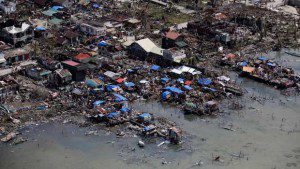
In Florida, we live Hurricanes. I remember the summer of 2004, I left a tropical storm filled study abroad program in Santo Domingo to return to the wrath of Hurricanes Charlie, Francis, and Jeanne in Orlando. We watched the despair of folks who suffered and were displaced in Louisiana the next year after Katrina hit Louisiana in 2005. Hurricane Katrina would become the costliest in the United States, causing over $80 billion in property damage. The winds from Hurricane Andrew that devastated South Florida in 1992 sent my aluminum patio flying across the street, bending in half a traffic sign that stopped its flight before tearing through a neighbor’s home.
The Philippine people know “typhoons ,” our version of hurricanes. This nation of over 7,100 islands feel as many as ten typhoons in any given year. The coastal city of Tacloban and its 220,000 inhabitants felt the brunt of Super-Typhoon Haiyan that recently hit the Philippines. Their property was decimated. Over 2,300 have died and over 600,000 displaced. People are injured and medical centers have inadequate medical supplies. Women and children are crying because they are hungry and thirsty. The airport has just become available, so relief is slowly trickling through blocked and damaged roads.
Super-Typhoon Haiyan hit the Philippines as a category 5 storm. The United States has not seen the effects of a category 5 storm at landfall since Andrew. But to compare, Hurricane Katrina had sustained winds of 126 mph, Typhoon Haiyan had sustained winds of 195 mph.
Looting in the aftermath is widespread. Security forces have exchanged fire in some instances and shot into the air to spread crowds. The devastation has triggered anarchy in some areas.
The U.S. Military has helped transport over 400 relief workers and some aid is beginning to reach remote areas. It could be one the largest relief efforts ever undertaken by our military in the Pacific. The situation is said to be improving but the images from international media outlets are still heart wrenching.


